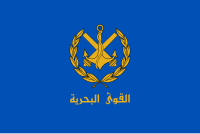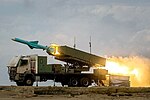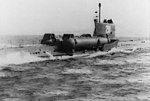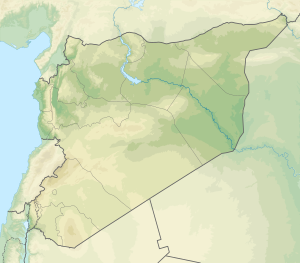Syrian Navy
| Syrian Arab Navy | |
|---|---|
| البحرية العربية السورية | |
 Flag of the Syrian Arab Navy | |
| Founded | August 29, 1950 |
| Country | |
| Type | Navy |
| Role | Naval warfare |
| Size | 4,000 active[1] 2,500 reserve[2] |
| Part of | |
| Garrison/HQ | Damascus, Syria |
| Anniversaries | 29 August |
| Equipment | 22 missile boats 14 patrol crafts 7 minesweepers 3 landing crafts 1 training ship |
| Engagements | |
| Commanders | |
| President of Syria | Marshal Bashar al-Assad |
| Minister of Defense | Lt. Gen. Ali Mahmoud Abbas |
| Chief of Naval Staff | Vice Admiral Yasser al-Haffi[3] |
| Aircraft flown | |
| Helicopter | Mil Mi-14, Kamov Ka-25, Kamov Ka-28 |
The Syrian Navy (SyN or SN), officially the Syrian Arab Navy (SyAN or SAN; Arabic: الْبَحْرِيَّةُ الْعَرَبِيَّةُ السُّورِيَّةُ, romanized: al-Baḥrīyah al-ʿArabīyah as-Sūrīyah), is the naval branch of the Syrian Armed Forces. The main role of the Syrian Navy is to defend the country's coasts and ensure the security of the territorial waters of Syria. The Coastal Defense Forces and the Syrian Marines have been attached to the Navy since the late 20th century. The Syrian Navy is a relatively small navy with only 4,000 sailors, in addition to 2,500 reservists and 1,500 marines. It is under the Syrian Army's Latakia regional command with its fleet based in the ports of Baniyas, Latakia, Minet el-Beida, and Tartus. It is the smallest part of the Syrian Armed Forces.
History
[edit]On 29 August 1950, the Syrian Navy was established following the procurement of a few naval vessels from France. The initial personnel consisted of army soldiers who had been sent to French naval academies for training.[4]
29 August is considered an annual holiday for the Syrian navy, which is celebrated every year,[5] and it was also chosen because it was the anniversary of the naval Battle of the Masts in 654.
Yom Kippur War
[edit]During the Yom Kippur War on 6–7 October 1973, the Syrian Arab Navy engaged for the first time in naval battle with Israeli ships in the Latakia area. It was the first battle in history in which both sides used sea-to-sea missile boats in combat.[6]
The Israeli Navy had five missile boats launched from the port of Haifa towards the main positions of the Syrian fleet off the coast City. At first, the Israeli fleet encountered a small reconnaissance boat, and immediately sank it. Then the ships reached a naval minesweeper, which they attacked and immediately downed.[7]
When the Israeli fleet advanced, it found the main forces of the Syrian fleet, the strongest and most modern militarily, which consisted of three missile boats (two Komar-class missile boats along with an Osa I-class missile boat, a K-123 torpedo boat and a T43-class minesweeper).[8]
The Syrian boats launched their missiles from a long range that the Israeli ships could not launch from. However, the Israeli fleet had an anti-missile system that could mislead its radars and keep them away from their targets. In real combat however, they succeeded completely and all the missiles missed the target. As a result of the battle, all 5 Syrian ships participating in it were sunk, the Israelis did not suffer any losses.[9]
On 29 August 1989, a Syrian missile boat sank the Maltese tanker Sunshield, which attempted to enter the prohibited zone.[10]
Syrian civil war
[edit]During the Syrian Civil War, opposition activists claimed that Syrian Navy warships supported a military attack by government forces against rebels in the city of Latakia.[11] But the government denied that the city was bombed by sea.[12]
Ranks
[edit]The rank insignia of commissioned officers.
| Rank group | General / flag officers | Senior officers | Junior officers | Officer cadet | ||||||||||||||||||||||||||||||||
|---|---|---|---|---|---|---|---|---|---|---|---|---|---|---|---|---|---|---|---|---|---|---|---|---|---|---|---|---|---|---|---|---|---|---|---|---|

|

|

|

|

|

|

|

|

|

|
|||||||||||||||||||||||||||
| فريق Fariq |
عماد أول Eimad 'awal |
عماد Eimad |
لواء Alliwa' |
عميد Amid |
عقيد Aqid |
مقدم Muqaddam |
رائد Ra'id |
نقيب Naqib |
ملازم أول Mulazim awwal |
ملازم Mulazim |
||||||||||||||||||||||||||
The rank insignia of non-commissioned officers and enlisted personnel.
| Rank group | Senior NCOs | Junior NCOs | Enlisted | |||||||||||||||||||||||||||||||||
|---|---|---|---|---|---|---|---|---|---|---|---|---|---|---|---|---|---|---|---|---|---|---|---|---|---|---|---|---|---|---|---|---|---|---|---|---|
| No insignia | ||||||||||||||||||||||||||||||||||||
| مساعد أول Musaeid 'awal |
مساعد ثاني Musaeid thani |
مساعد Musaeid |
رقيب أول Raqib 'awal |
رقيب ثاني Raqib thani |
رقيب Raqib |
عريف Earif |
جندي أول Jundiun 'awal |
جندي Jundiun | ||||||||||||||||||||||||||||
Personnel
[edit]The number of recruits for the Syrian Arab Navy has reached 4,000 soldiers and 2,500 reservists since the year 1985, and this number has not changed in the census in 2002. The proportion of navy personnel from the total number of recruits Syrian Arab Army was 1.4% in the year 1993.[14] This rose to 1.9% of the total armed forces personnel in the year 2000.[15]
Structure
[edit]The Syrian Arab Navy consists of the navy, coastal defense and naval aviation forces.
Marines
[edit]The Syrian Marines follows the forces of naval infantry, consisting of about 1,500 conscripts, whose primary role is to protect the three military naval bases in the country, which are divided into three units, each of which is to protect one of the bases. These Marines have three amphibious assault ships, each of which can carry 100 soldiers and five tanks.
In general, the Syrian Marine Corps did not receive any special or advanced armament and very little training in the use of amphibious ships, and in general its recruits are only ordinary soldiers and do not have any experience in the ways of fighting as Marines. Although the Soviet Union set up part of Exercise Zapad-81 (the largest military training exercise ever in the entire history of the Soviet Union, and included the largest amphibious landing operation in its history as well), the Syrian soldiers did not participate.
The marines did not participate in any real amphibious naval landing during any of the wars Syria was involved in. Instead, they were used as infantry with a direct ground clash in the October War and in the Lebanon Civil War. During the Second Gulf War, Syria put all its marines together with the 17,000 soldiers it sent to Kuwait, which may mean that it considers them highly experienced soldiers.[4]
Coastal Defense
[edit]The Syrian Coastal Defense Forces were placed under the command of the Syrian Arab Navy since 1984. The coastal defense consists of brigade infantry, each of which is responsible for monitoring a specific coastal sector, and in addition to them, there is a battalion that monitors. In addition to these forces, there are two artillery battalions armed with 18 artillery pieces, 130 mm caliber M-46.[16] The Syrian coastal defense is also armed with Styx, Sepal, YJ-83 and P-800 Oniks missiles, as well as K-300P Bastion-P coastal defense missile system.[4][17]
Bases
[edit]Syrian Navy's headquarters is in Damascus and main base is at Latakia on the Mediterranean Sea with other naval bases at Baniyas, Tartus and Minet el-Beida.[4]
Latakia is Syria’s largest and most active port, as it has 23 berths, and it includes a section for the repair of military ships within its sectors, and some of the navy’s fast missile boats dock in it.[18][19][20]
Al-Bayda port is located in the city of Baniyas, it was built specifically for naval military purposes. There are also training centers for naval officers and special soldiers in the port, and some transport ships dock there.[4]
The Port of Tartus is the main base of the Syrian Navy, where the two navy frigates, its three amphibious ships and all its minesweepers dock, as well as some missile boats and navy transport ships.[4] and includes the port 22 A dock with an area of three million square meters.[4] With the arrival of the Russian Air Force at Bassel Al-Assad International Airport in 2015, the Syrian Naval Aviation helicopters moved a few miles north to Istamo after a new helicopter base was established at the arms depot.[21]
Russian base in Tartus
[edit]Tartus hosts a Soviet-era naval supply and maintenance base, under a 1971 agreement with Syria. The base was established during the Cold War to support the Soviet Navy's fleet in the Mediterranean Sea. Since Russia forgave Syria three-fourths of its $13.4 billion Soviet-era debt and became its main arms supplier, the two countries have conducted talks about allowing Russia to develop and enlarge its naval base, so that Russia can strengthen its naval presence in the Mediterranean.[22] Amid Russia's deteriorating relations with the West, because of the 2008 Russo-Georgian War and plans to deploy a US missile defense shield in Poland, President Assad agreed to the port’s conversion into a permanent Middle East base for Russia’s nuclear-armed warships.[23] Since 2009, Russia has been renovating the Tartus naval base and dredging the port to allow access for its larger naval vessels.[24]
Fleet
[edit]Ship
[edit]| Class | Image | Type | Ships | Origin | Quantity | Notes |
|---|---|---|---|---|---|---|
| Missile boat | ||||||
| Osa I & Osa II |  |
Missile boat | 16 | 6 Osa I and 10 Osa II | ||
| Tir II (IPS 18) |  |
Fast Attack Craft Torpedo boat | 6 | Believed to be locally produced by Maritime Industries Group or copies of North Korean patrol boats. | ||
| Patrol craft | ||||||
| Zhuk class |  |
Patrol craft | 8 | 23.8 m inshore vessels. | ||
| MIG-S-1800 class |  |
Patrol craft | 6 | Monohull and catamaran produced by Maritime Industries Group with longer variants (S-1900 and S-2600).[25] | ||
| Minesweeper | ||||||
| Sonya class |  |
Minesweeper | 1 | |||
| Yevgenya class |  |
Minesweeper | 5 | |||
| Natya class |  |
Minesweeper | 1 | |||
| Amphibious warfare | ||||||
| Polnocny B |  |
Landing ship tank | 3 | |||
| Training ship | ||||||
| Unknown | Training ship | Al Assad | 1 | 3,500-ton. Used as a cadet training ship by the Syrian naval academy.[26] | ||
Naval aviation
[edit]- 63rd Helicopter Brigade
- 618th Maritime Warfare Squadron[21]
| Aircraft | Image | Version | Type | Origin | Quantity | Notes |
|---|---|---|---|---|---|---|
| Helicopters | ||||||
| Mil Mi-14 |  |
Haze-A Haze-C |
Anti-submarine helicopter Search and rescue helicopter |
18 | ||
| Kamov Ka-28 |  |
Helix-A | Anti-submarine helicopter | 4 | ||
Coastal defence
[edit]| Model | Image | Type | Origin | Quantity | Notes | |
|---|---|---|---|---|---|---|
| Coastal defence | ||||||
| C-802 | 
|
Anti-ship cruise missile | (CSS-N-8 Saccade)[27] | |||
| Noor | 
|
Anti-ship cruise missile | 10 systems | Delivered between 2009 and 2010.[28] | ||
| K-300P Bastion-P / P-800 Yakhont | 
|
Mobile anti-ship and surface-to-surface missile | 4 systems | (SS-C-5 Stooge) | ||
| P-5 Pyatyorka | 
|
Cruise missile | 4 systems | (SS-C-1 Sepal) | ||
| P-15M/P-22[1] | 
|
Anti-ship missile | 6 systems | (SS-C-3 Styx) | ||
| M1954 | 
|
Field gun | N/A | M-46 | ||
Former vessels
[edit]The Syrian Navy once operated three Project 613 submarines. These were former the Soviet boats S-167, S-171, and S-183.[29]
They operated three Romeo-class submarines (S-1, S-53, S-101). Built in 1961 for Soviet Navy and transferred to Syria 1985-1987, decommissioned by mid-1990s and all scrapped by 1996.[30]
Syria had two Vanya-class minesweepers since 1972. All ships were retired by the mid-1990s.
They also had two Petya-class frigates in derelict condition at Tartus port.[31] Both probably retired in 2017 or 2018. One decommissioned Syrian frigate was sunk by the Russian Air Force as a training target on 15 April 2018 off the coast of Syria.[32]
List of vessels
[edit]The following table shows the strength of the Syrian Arab Naval Forces according to the year since 1990, in addition to the deals to be concluded in this regard until 2015:[4]
| Class | Origin | 1990 | 1995 | 2000 | 2005 | 2010 | 2012 | 2015 |
|---|---|---|---|---|---|---|---|---|
| Amur-1650 submarine | 2 | |||||||
| Project 633 submarine | 3 | 1 | ||||||
| Petya-class frigate | 2 | 2 | 2 | 2 | 2 | 2 | 2 | |
| Osa-class missile boat | 12 | 14 | 10 | 12 | 10 | 16 | 16 | |
| Komar-class missile boat | 4 | 4 | ||||||
| Tir-class speedboat | 6 | 6 | 6 | |||||
| Zhuk-class patrol boat | 8 | 8 | 8 | 8 | 8 | 8 | 8 | |
| Yevgenya-class minesweeper | 4 | 5 | 3 | 3 | 3 | 5 | 5 | |
| Natya-class minesweeper | 1 | 1 | 1 | 1 | ||||
| Sonya-class minesweeper | 1 | 1 | 1 | 1 | 1 | 1 | 1 | |
| T43-class minesweeper | 1 | 1 | 1 | 1 | 1 | |||
| Vanya-class minesweeper | 2 | |||||||
| Polnocny-class landing ship | 3 | 3 | 3 | 3 | 3 | 3 | 3 | |
| Training ship Al-Assad | 1 | 1 | 1 | 1 | 1 | 1 | 1 | |
| Support ships | Unknown | 2 | 3 | 3 | 2 | |||
| Ghaem-class patrol boat | 6 | 6 | 6 |
Recent developments
[edit]Russia and Iran
[edit]In general, the Syrian Arab Navy did not have any modern equipment or weapons until 2006 (except for the OSA I and II anti-ship missile boats), in addition to its modest numbers of recruits compared to the 150-kilometre long Syrian coast. But since 2006, Russia and Iran began providing Syria with advanced weapons, providing it with heavy, short-range land-sea missiles, which are less expensive and more effective in battles than expensive torpedoes and boats, which are easily endangered during sea battles.[33]
Among the types of missiles that Iran and Russia supplied to the Syrian Navy are the Styx anti-ship missiles, intended for use in close-range missile engagement with battleships and warships. In recent years, they have also acquired an unknown number of Sepal missiles, and their possession was not known until they appeared in modern combat tests of the Syrian Arab Army in late 2011.[34]
The Syrian Navy also has a third type of missile, the Russian-made Yakhont missiles, which Syria purchased from Russia in a military deal in late 2011.[35] These are long-range missiles that have given Syria a strategic military advantage at the Eastern Mediterranean.[33] As for the fourth type of missiles supplied to the Syrian Navy, it is the C-802 anti-ship missile of Chinese origin, which is believed to have been supplied to Syria by Iran.[36]
Syrian Navy hopes to receive two Amur-1650 class submarines. In 2015 a group of Syrian military officials arrived in Moscow to discuss prospects for bilateral military and technical cooperation, including the pair of submarines.[4] The Project-677 or Lada-class diesel submarine, whose export version is known as the Amur 1650, features a new anti-sonar coating for its hull, an extended cruising range, and advanced anti-ship and anti-submarine weaponry.
References
[edit]- ^ a b The military balance. 2023. James Hackett, International Institute for Strategic Studies. London. 2023. ISBN 978-1-003-40022-6. OCLC 1372013483.
{{cite book}}: CS1 maint: location missing publisher (link) CS1 maint: others (link) - ^ The Military Balance 2021 page 366
- ^ قائد القوى البحرية: سورية تواجه أعتى الحروب وستنتصر على الإرهاب Archived 2018-12-24 at the Wayback Machine
- ^ a b c d e f g h i "Syrian Arab Navy". GlobalSecurity.org.
- ^ Under patronage of President al-Assad, Syrian Navy celebrates foundation day. Syrian Arab News Agency. Published 29 August 2022.
- ^ Latakia Battle. Access-date 19-04-2012. Archived 5 May 2012 at the Wayback Machine
- ^ Battle of Latakia. Sudanese Radio Information Center. Accessed 19-04-2012. Archived 22 March 2016 at the Wayback Machine [dead link]
- ^ Rabonovich, The Boats of Cherbourg, pp. 256–262.
- ^ Lerner, Adi (7 October 2011). "The Untold Story of Naval Heroism in the Yom Kippur War". Maariv (in Hebrew). Retrieved 7 October 2011.
- ^ "Сирийские вертолёты над Ливаном". Archived from the original on 2018-06-18. Retrieved 2014-06-22.
- ^ "Syrian 'warships shell port city of Latakia'". Al Jazeera. 14 August 2011.
- ^ Tanks and warships bombarding neighborhoods in the city of Latakia And dozens of deaths. France 24 Channel. Published: August 15, 2011. Accessed August 19, 2011. "Archived copy". Archived from the original on 6 March 2018. Retrieved 11 October 2022.
{{cite web}}: CS1 maint: archived copy as title (link) CS1 maint: bot: original URL status unknown (link) - ^ a b "شعار الرأس" [Main logo]. mod.gov.sy (in Arabic). Ministry of Defence (Syria). Retrieved 12 October 2021.
- ^ International Arab Encyclopedia - Second Edition (1999 CE), For “Encyclopedia Business for Publishing and Distribution”, Volume No. 13 letter (S), p. 219.
- ^ The book “ALMANAC 2003” from Encyclopedia Britannica, p. 650.
- ^ "Syrie: rudes combats à Abou Dali entre les djihadistes d'Hayat Tahrir al-Cham et le régime de Damas". France Soir (in French). 19 October 2017. Archived from the original on 29 June 2018. Retrieved 28 June 2018.
- ^ Mitzer, Stijn; Oliemans, Joost (5 August 2016). "Photo Report: The Syrian Arab Navy". Oryx Blog.
- ^ مرفأ اللاذقي موقع غرفة الملاحة البحرية السورية. تاريخ الولوج [permanent dead link]
- ^ "عنوانسخة مؤرش". Archived from the original on 9 March 2016.
- ^ "حول مرفأ اللاذقية". Archived from the original on 23 September 2017. Retrieved 19 April 2012.
- ^ a b SYRIAN ARAB NAVAL AIR ARM
- ^ Weitz, Richard (2010). Global security watch--Russia : a reference handbook. Santa Barbara, Calif.: Praeger Security International. p. 30. ISBN 978-0-313-35434-2.
- ^ "Big Russian flotilla led by Admiral Kuznetsov carrier heads for Syrian port". DEBKAfile. 21 August 2008. Archived from the original on 23 August 2008. Retrieved 7 October 2012.
- ^ "INSS: Syria Report" (PDF). Institute for National Security Studies. Archived from the original (PDF) on 2 October 2011. Retrieved 3 September 2011.
- ^ Shapir, Yiftah (August 2007), "The Syrian Army Buildup" (PDF), Strategic Assessment, 10 (2), Tel Aviv, Israel: The Institute for National Security Studies
- ^ Re-examining Syria from a naval perspective. Naval-technology.com. Published 3 September 2013.
- ^ C-802 in Syria 7/7/2012 (video)
- ^ "Trade Registers". Archived from the original on 29 December 2017. Retrieved 13 November 2014.
- ^ "Medium Submarines Project 613". RussianShips.info. Retrieved 22 February 2021.
- ^ "Syrian Navy".
- ^ Oryx. "Photo Report: The Syrian Arab Navy". Oryx Blog. Retrieved 2021-08-13.
- ^ Marjanović, Marko (2018-04-26). "Russian Navy Hit and Sank a Decommissioned Frigate in Syria Live Fire Drills (VIDEO)". Anti-Empire. Retrieved 2021-08-13.
- ^ a b استنفار في القوى البحرية السورية والطوربيدات خضعت للصيانة وضعت في حالة تأهب قصوى. تاريخ النشر 03-03-2008. تاريخ الولوج 18-04-2012. Archived 2011-03-01 at the Wayback Machine
- ^ التفوق الإستراتيجي في البحر المتوسط لصالح البحرية السورية. تاريخ النشر 08-03-2012. تاريخ الولوج 18-04-2012. Archived 2018-06-23 at the Wayback Machine
- ^ Haaretz (1 December 2011). "Report: Russia delivers supersonic cruise missiles to Syria". Haaretz. Archived from the original on 2 December 2011. Retrieved 1 December 2011.
- ^ The International Institute for Strategic Studies 2022, p. 273.
Works cited
[edit]- The International Institute for Strategic Studies (14 February 2022). The Military Balance 2022. Routledge. ISBN 978-1-000-62003-0.


